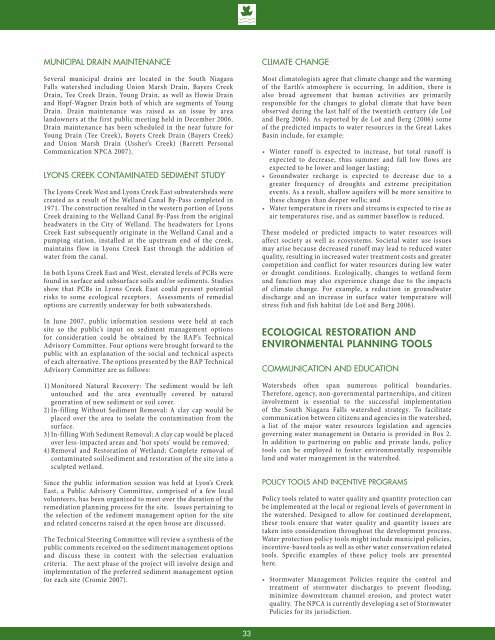8132 - NPCA SNF Watershed Report.indd - Niagara Peninsula ...
8132 - NPCA SNF Watershed Report.indd - Niagara Peninsula ...
8132 - NPCA SNF Watershed Report.indd - Niagara Peninsula ...
You also want an ePaper? Increase the reach of your titles
YUMPU automatically turns print PDFs into web optimized ePapers that Google loves.
Municipal Drain MaintenanceSeveral municipal drains are located in the South <strong>Niagara</strong>Falls watershed including Union Marsh Drain, Bayers CreekDrain, Tee Creek Drain, Young Drain, as well as Howie Drainand Hopf-Wagner Drain both of which are segments of YoungDrain. Drain maintenance was raised as an issue by arealandowners at the first public meeting held in December 2006.Drain maintenance has been scheduled in the near future forYoung Drain (Tee Creek), Boyers Creek Drain (Bayers Creek)and Union Marsh Drain (Ussher’s Creek) (Barrett PersonalCommunication <strong>NPCA</strong> 2007).Lyons Creek Contaminated Sediment StudyThe Lyons Creek West and Lyons Creek East subwatersheds werecreated as a result of the Welland Canal By-Pass completed in1971. The construction resulted in the western portion of LyonsCreek draining to the Welland Canal By-Pass from the originalheadwaters in the City of Welland. The headwaters for LyonsCreek East subsequently originate in the Welland Canal and apumping station, installed at the upstream end of the creek,maintains flow in Lyons Creek East through the addition ofwater from the canal.In both Lyons Creek East and West, elevated levels of PCBs werefound in surface and subsurface soils and/or sediments. Studiesshow that PCBs in Lyons Creek East could present potentialrisks to some ecological receptors. Assessments of remedialoptions are currently underway for both subwatersheds.In June 2007, public information sessions were held at eachsite so the public’s input on sediment management optionsfor consideration could be obtained by the RAP’s TechnicalAdvisory Committee. Four options were brought forward to thepublic with an explanation of the social and technical aspectsof each alternative. The options presented by the RAP TechnicalAdvisory Committee are as follows:1) Monitored Natural Recovery: The sediment would be leftuntouched and the area eventually covered by naturalgeneration of new sediment or soil cover.2) In-filling Without Sediment Removal: A clay cap would beplaced over the area to isolate the contamination from thesurface.3) In-filling With Sediment Removal: A clay cap would be placedover less-impacted areas and ‘hot spots’ would be removed.4) Removal and Restoration of Wetland: Complete removal ofcontaminated soil/sediment and restoration of the site into asculpted wetland.Since the public information session was held at Lyon’s CreekEast, a Public Advisory Committee, comprised of a few localvolunteers, has been organized to meet over the duration of theremediation planning process for the site. Issues pertaining tothe selection of the sediment management option for the siteand related concerns raised at the open house are discussed.The Technical Steering Committee will review a synthesis of thepublic comments received on the sediment management optionsand discuss these in context with the selection evaluationcriteria. The next phase of the project will involve design andimplementation of the preferred sediment management optionfor each site (Cromie 2007).Climate ChangeMost climatologists agree that climate change and the warmingof the Earth’s atmosphere is occurring. In addition, there isalso broad agreement that human activities are primarilyresponsible for the changes to global climate that have beenobserved during the last half of the twentieth century (de Loëand Berg 2006). As reported by de Loë and Berg (2006) someof the predicted impacts to water resources in the Great LakesBasin include, for example:• Winter runoff is expected to increase, but total runoff isexpected to decrease, thus summer and fall low flows areexpected to be lower and longer lasting;• Groundwater recharge is expected to decrease due to agreater frequency of droughts and extreme precipitationevents. As a result, shallow aquifers will be more sensitive tothese changes than deeper wells; and• Water temperature in rivers and streams is expected to rise asair temperatures rise, and as summer baseflow is reduced.These modeled or predicted impacts to water resources willaffect society as well as ecosystems. Societal water use issuesmay arise because decreased runoff may lead to reduced waterquality, resulting in increased water treatment costs and greatercompetition and conflict for water resources during low wateror drought conditions. Ecologically, changes to wetland formand function may also experience change due to the impactsof climate change. For example, a reduction in groundwaterdischarge and an increase in surface water temperature willstress fish and fish habitat (de Loë and Berg 2006).Ecological Restoration andEnvironmental Planning ToolsCommunication and Education<strong>Watershed</strong>s often span numerous political boundaries.Therefore, agency, non-governmental partnerships, and citizeninvolvement is essential to the successful implementationof the South <strong>Niagara</strong> Falls watershed strategy. To facilitatecommunication between citizens and agencies in the watershed,a list of the major water resources legislation and agenciesgoverning water management in Ontario is provided in Box 2.In addition to partnering on public and private lands, policytools can be employed to foster environmentally responsibleland and water management in the watershed.Policy Tools and Incentive ProgramsPolicy tools related to water quality and quantity protection canbe implemented at the local or regional levels of government inthe watershed. Designed to allow for continued development,these tools ensure that water quality and quantity issues aretaken into consideration throughout the development process.Water protection policy tools might include municipal policies,incentive-based tools as well as other water conservation relatedtools. Specific examples of these policy tools are presentedhere.• Stormwater Management Policies require the control andtreatment of stormwater discharges to prevent flooding,minimize downstream channel erosion, and protect waterquality. The <strong>NPCA</strong> is currently developing a set of StormwaterPolicies for its jurisdiction.33
















